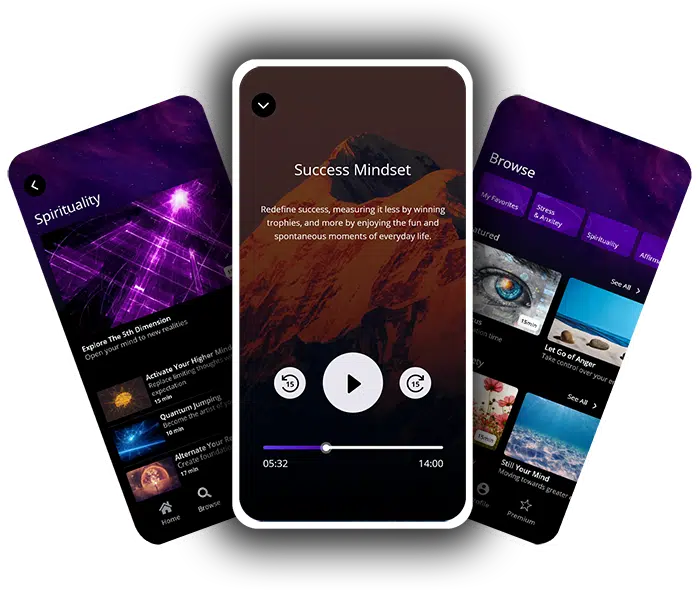Ever felt stuck, as if your abilities have hit an invisible ceiling? Consider this: science shows our brains are far more adaptable than we once thought. Our blog dives into the powerful contrast between growth mindset vs fixed mindset, unpacking how a shift in perspective can unlock potential and overcome limits.
Get ready—it’s time to expand your mind!

Unleash Your True Potential!
Explore the world of meditation with our powerful guided sessions crafted to bring peace and strength to your spirit.
But first, let’s ensure our sessions are the perfect fit for you.
Take our short quiz to find out!
Table of contents
- Understanding the Difference Growth Mindset Vs. Fixed Mindset
- Comparing the Pros and Cons
- The Science Behind Growth Mindset Development
- Carol Dweck: A Summary of Growth and Fixed Mindsets
- How to Cultivate a Growth Mindset
- Challenges of Adopting a Growth Mindset
- Understanding the Benefits of a Fixed Mindset
- Leveraging a Growth Mindset for Success
- Conclusion
- FAQs
Understanding the Difference Growth Mindset Vs. Fixed Mindset
A growth mindset is characterized by belief that skills, intelligence and abilities can be developed through dedication and hard work. On the other hand a fixed mindset holds the belief that talents and skills are innate and unchangeable.
Understanding these mindsets is crucial for personal and professional development.

Definitions of Both Mindsets
Understanding the core principles of growth and fixed mindsets is crucial for personal development. Key differences between the two can shape one’s approach to challenges, learning, and overall perspective on self-improvement.
| Growth Mindset | Fixed Mindset |
|---|---|
| Intelligence and abilities are seen as fluid and developable through effort and persistence. | Intelligence and abilities are viewed as static, innate traits that individuals cannot change. |
| Challenges are embraced as opportunities to improve, learn and grow. | Challenges may be avoided due to fear of failure or judgment. |
| Effort is recognized as a path to mastery and accomplishment. | Effort is often seen as futile if the ability is perceived as insufficient. |
| Feedback and criticism are valued for personal and professional development. | Feedback and criticism can be taken personally or seen as an attack on one’s abilities. |
| Success of others is inspiring and serves as a motivation to grow. | Success of others might trigger feelings of insecurity or jealousy. |
| Failures are regarded as learning moments, not a reflection of one’s worth or potential. | Failures are often internalized, leading to a belief that ability is lacking. |
Exploring these definitions helps individuals identify their mindset. It also helps understand the impact it has on their behavior and success. Those with a growth mindset are more likely to engage in continuous learning and self-improvement, whereas individuals with a fixed mindset may limit their potential by avoiding tasks that challenge their perceived capabilities.
Common Myths about Fixed Mindset
Now that we know what fixed and growth mindsets are, let’s talk about some wrong ideas people have about having a fixed mindset. Many think if you have a fixed mindset, you can’t ever change it.
This isn’t true! Your brain can grow and make new connections no matter how old you are. Another myth is that only people with bad self-esteem have a fixed mindset. In fact, even confident folks can think their skills won’t get better.
Some believe if someone has talents in one area, they must be stuck with a fixed mindset forever. But this isn’t the case either; everyone has parts of both mindsets inside them. It’s also not right to say that praising kids for being smart helps them learn better—this can actually hold back their willingness to try hard things or risk making mistakes.
Remember, getting smarter isn’t just about our brains; it’s also about trying over and over again until we succeed!
Comparing the Pros and Cons

Both mindsets have their own set of benefits and challenges, with a fixed mindset providing a sense of stability and security but also limiting opportunities for growth. On the other hand, a growth mindset offers resilience and adaptability, allowing individuals to embrace challenges and learn from failures.
Striking a balance between the two mindsets is essential for personal and professional development.
The benefits and challenges of each mindset
A growth mindset can open doors to new learning and personal success. A fixed mindset might make us think we can’t change, which isn’t helpful.
- Mistakes become lessons: With a growth mindset, you see mistakes as chances to learn.
- You say yes to challenges: Being ready for hard things helps you grow.
- Effort counts: Working hard is seen as key to getting better.
- You keep going: Setbacks don’t stop someone with a growth mindset.
- Skills can grow: You believe you can always get better at something.
- It’s hard work: Keeping a growth mindset takes constant effort.
- Disappointment happens: Sometimes growth doesn’t come fast, and that’s tough.
- Overwhelm is possible: Wanting to improve everything all at once may be too much.
- Safety in the known: Staying with what you’re good at feels safe.
- Less stress initially: Avoiding challenges might mean less worry for now.
- Clear limits: Knowing your boundaries can give comfort.
- Missed chances: Saying no to new experiences means missing out on what could be great opportunities.
- Stunted growth: Believing skills are set in stone doesn’t let you improve or learn new things.
- Frustration sets in: Seeing others succeed while thinking you can’t change is disheartening.
The importance of balance and flexibility
When comparing a growth mindset and a fixed mindset, it’s crucial to understand the importance of balance and flexibility. Finding the right balance between the two mindsets can allow individuals to embrace challenges with perseverance while also acknowledging their strengths and achievements.
Flexibility enables one to adapt to different situations, learning from both successes and setbacks. It empowers individuals to maintain an optimistic outlook while being open-minded towards new opportunities for growth, creating a healthy equilibrium between persistence and adaptability.
Balancing these mindsets is essential for personal development and success in various aspects of life, as it fosters resilience, innovation, and continuous improvement. This equilibrium allows individuals to harness the benefits of both mindsets while mitigating their respective limitations, leading to a more holistic approach towards achievement and fulfillment.
The Science Behind Growth Mindset Development

Understanding the science behind growth mindset development involves delving into the concept of neuroplasticity and its impact on personal and professional growth. By exploring how our brains can create new neural pathways through deliberate practice and self-regulation, we gain insights into the potential for continuous learning and development.
Neuroplasticity
Neuroplasticity refers to the brain’s ability to change and adapt, even beyond childhood. This ability is crucial for developing a growth mindset. Understanding neuroplasticity can help children learn about their brains and encourage them to cultivate a growth mindset from an early age.
It means that our brains are not fixed; they can form new connection and pathways throughout our lives, empowering us with the potential for continuous learning and personal development.
By embracing neuroplasticity, individuals can shift from fixed mindset to growth mindset, fostering resilience, curiosity, and a willingness to take on challenges. Understanding this concept helps people realize that they have the power to improve their abilities and intelligence through effort and perseverance.
Benefits for Personal and Professional Growth
Individuals with a growth mindset experience higher motivation and are more likely to correct errors, leading to personal development. A growth mindset is linked to a lifelong love of learning, improved career success, and continuous evolution.
Moreover, it encourages resilience, fosters continuous learning, and supports professional development while creating an environment conducive to personal progression outside the traditional workplace setting.
Carol Dweck: A Summary of Growth and Fixed Mindsets
Carol Dweck’s research has identified the differences between growth and fixed mindsets, emphasizing the importance of cultivating qualities through effort. Understanding these mindsets can lead to personal and professional growth, making it important to delve deeper into this topic.
Dweck’s research and findings
Carol Dweck, a prominent psychologist, introduced the concept of fixed mindset and growth mindset. The research she has done shows that individuals with growth mindset believe that their abilities can be developed with dedication and hard work.
In contrast, those with fixed mindset believe their abilities are innate and unchangeable. Studies suggest that having a growth mindset leads to greater motivation and achievement.
Dweck’s findings emphasize the significance of cultivating a growth mindset for personal and professional development. She posits that embracing challenges, persisting in the face of setbacks, and seeing effort as a path to mastery are vital components of this outlook.
The two mindsets
Psychologist Carol Dweck has identified two mindsets: the fixed mindset and the growth mindset. In fixed mindset, people believe that their talents and intelligence are static traits.
On the other hand, those with a growth mindset embrace challenges and see opportunities for learning and improvement. This distinction is crucial as it affects how individuals approach obstacles, feedback, and ultimately their own potential for success in various areas of life.
Putting it into practice
To put the growth mindset into practice:
- Recognize that abilities can be developed through effort, dedication, and perseverance.
- Focus on the process of learning and improvement rather than seeking validation or approval from others.
- Embrace challenges as opportunities for learning and growing. Looking at failure as stepping stones toward success.
- Seek constructive feedback from mentors or peers to gain insights for continuous improvement.
- Step out of comfort zones to explore more new experiences and expand personal horizons.
- Set learning-oriented goals that prioritize skill development and progress over achieving perfection.
- Cultivate a culture of growth mindset in the workplace by encouraging open communication, innovation, and adaptability.
How to Cultivate a Growth Mindset

To cultivate growth mindset, individuals can start with meditating and working on their intent for growth. It can help them realize their potential for improvement and focusing on the process rather than just the results. Overcoming negative self-talk, seeking constructive feedback, and stepping out of comfort zones are essential actions to develop a growth-oriented mindset.

Unleash Your True Potential!
Explore the world of meditation with our powerful guided sessions crafted to bring peace and strength to your spirit.
But first, let’s ensure our sessions are the perfect fit for you.
Take our short quiz to find out!
Realizing the Potential for Improvement
Realizing the potential for improvement is crucial and can lead to significant professional and personal growth. It involves recognizing that abilities, intelligence, and skills can be enhanced through effort and learning. Here are some actionable insights for realizing the potential for improvement:
- Embrace challenges as opportunities of growth, rather than obstacles.
- Set specific learning-oriented goals to focus on gradual progress.
- Seek out new experiences and knowledge to enhance your capabilities.
- Adopt a positive attitude towards failure as part of the learning process.
- Emphasize the journey of improvement rather than fixating on immediate results.
- Surround yourself with supportive people who inspire your growth.
Overcoming Negative Self-Talk
To overcome negative self-talk:
- Recognize the thought patterns that contribute to negative self-talk and acknowledge that these thoughts are not facts.
- Challenge negative self-talk by replacing it with self-talk that are positive. You can also try realistic affirmations that promote self-compassion and confidence.
- Practice mindfulness to observe and detach from negative thoughts, allowing space for objective evaluation and reframing of perspectives.
- Seek support from friends, family, or a professional to gain different insights and encouragement when dealing with negative self-talk.
- Engage in activities that boost self-esteem and celebrate personal achievements to counteract the influence of negative self-talk.
- Develop habit of gratitude by focusing on things to be thankful for, shifting attention away from negativity towards positivity.
Emphasizing the Process over Results
Emphasizing the Process over Results:
- Focus on the journey of learning and growth, rather than solely on end outcomes, to foster a mindset of continuous improvement.
- Cultivate an attitude that values effort, perseverance, and resilience in tackling challenges, acknowledging that progress is often nonlinear and requires patience.
- Encourage reflective practices that celebrate incremental achievements and recognize the learning experiences embedded within setbacks.
- Foster a curiosity-driven approach that prioritizes exploration, experimentation, and skill development as valuable elements of personal and professional advancement.
- Engage in goal-setting that emphasizes mastery and skill development, viewing achievements as stepping stones toward long-term progress.
- Promote a collaborative environment that values teamwork, feedback exchange, and knowledge sharing as integral components of the learning process.
Seeking Constructive Feedback

Seeking constructive feedback is essential for growth mindset development. It helps in identifying areas for improvement and learning from others’ perspectives. Here are some steps to effectively seek and utilize constructive feedback:
- Actively request specific feedback on your work or behavior to gain insights into areas needing improvement.
- Listen attentively without becoming defensive, ensuring you understand the feedback thoroughly before responding.
- Take notes on the feedback received, highlighting key points to reflect on later.
- Ask clarifying questions to ensure better understanding of the feedback provided.
- Identify patterns in the feedback received from multiple sources to recognize consistent areas for improvement.
- Develop an action plan based on the feedback, setting goals and strategies for improvement in targeted areas.
- Follow up with those providing feedback to share progress made based on their input, fostering ongoing dialogue and growth.
Stepping Out of Comfort Zones
Stepping out of your comfort zone is very important for developing a growth mindset. It encourages personal and professional growth and opens doors to new opportunities.
- Embracing Discomfort: Acknowledge that discomfort is a natural part of growth and change. See it as a sign that you are pushing your boundaries and expanding your capabilities.
- Setting Clear Goals: Define specific, achievable goals that push you beyond what feels comfortable. This provides direction and purpose, making it easier to step out of your comfort zone.
- Surrounding Yourself with Support: Build a network of supportive individuals who can encourage and guide you through the challenges of stepping out of your comfort zone. Seek out mentors or peers who have experience in this area.
- Seeing Challenges as Opportunities: View challenges as chances to learn, develop skills, and gain valuable experiences. This perspective helps reframe discomfort as a positive catalyst for growth.
- Cultivating Resilience: Develop resilience by embracing setbacks or failures as opportunities to improve rather than reasons to retreat back into your comfort zone.
Accepting Failure as Part of the Learning Process
Embracing failure as part of the learning process is crucial for personal and professional growth. It allows individuals to learn, adapt, and become better at what they do. Here are some actionable insights on how to accept failure as part of the learning process:
- Recognize that failure is a lesson for growth, not a setback. It provides a lot of valuable insights that can lead to improvement.
- Shift your mindset from viewing failure as a personal flaw to seeing it as a natural part of the journey toward success.
- Embrace a positive attitude towards failure, understanding that it is an essential step for learning process.
- Seek constructive feedback from failures to gain valuable insights that can guide future actions and decisions.
- Reframe failures as learning opportunities rather than definitive outcomes, focusing on the lessons gained from each experience.
- Encourage a culture where fails and mistakes are viewed as moments for learning rather than reasons for blame or shame.
- Cultivate resilience by acknowledging that setbacks are temporary. They can be overcome with determination.
Challenges of Adopting a Growth Mindset

Adopting a growth mindset can be challenging, as it often requires individuals to overcome their fear of failure, the pressure to be perfect, and imposter syndrome. Interested in learning more about how to navigate these challenges and cultivate a growth mindset? Keep reading for effective actionable strategies that can help you embrace a new perspective on personal and professional development.
Fear of Failure
Fear of failure can stop people from embracing a growth mindset. It can create anxiety and make them afraid to take risks. This fear can hold back personal and professional development.
Overcoming this fear involves changing the mindset towards failure, realizing that it is a natural part of learning and growth. Embracing growth mindset means being willing to learn from failing and making mistakes. It also means to keep moving forward, rather than being paralyzed by the fear of failure.
Pressure to be Perfect
The fear of failure often leads to feeling the pressure to be perfect, especially in academic or professional settings. This pressure can create a fixed mindset that focuses on avoiding mistakes rather than embracing challenges and learning from them.
It may result in individuals seeking validation through flawless performance and avoiding risks to maintain an ideal image. The belief in a growth mindset, on the other hand, encourages resilience in the face of imperfection and sees setbacks as opportunities for growth.
By understanding the hidden truth behind this pressure, individuals can begin to shift towards a more flexible and adaptive mindset.
Imposter Syndrome
Imposter syndrome affects many individuals, regardless of their background or achievements. It’s a feeling of inadequacy and self-doubt that can hinder personal and professional growth.
Those with a fixed mindset are particularly susceptible to imposter syndrome because they tend to believe that abilities are innate and unchangeable. However, cultivating a growth mindset through setting ambitious goals and challenging oneself can help combat these feelings of being an imposter.
In workplaces, fostering a culture that promotes psychological safety and embraces a growth mindset can alleviate imposter syndrome among employees, allowing them to thrive in their endeavors.
Understanding the Benefits of a Fixed Mindset
A fixed mindset can provide a sense of stability and security. It may offer comfort in believing that abilities and intelligence are predetermined, reducing the anxiety associated with uncertainty and change.
Embracing a fixed mindset might also create a foundation for consistent performance, as it adheres to the belief that one’s skills don’t fluctuate. This approach can lead to avoiding unnecessary risks or challenges and focusing on areas where individuals feel secure in their abilities.
Moreover, people with a fixed mindset may find it easier to maintain self-confidence even in the face of adversity. The notion of inherent ability allows them to anchor their self-worth without being overly influenced by external circumstances, fostering resilience against setbacks or criticism.
Leveraging a Growth Mindset for Success

Embracing growth mindset can lead to success by setting learning-oriented goals, embracing challenges, reframing failure as a learning opportunity, and encouraging a culture of growth mindset in the workplace.
These strategies can foster continuous improvement and resilience in the face of obstacles.
Setting Learning-Oriented Goals
Setting learning-oriented goals is crucial for fostering a growth mindset. Research also shows that people with a growth mindset tend to set goals focused on learning and development, rather than just achieving specific outcomes. Here are some practical strategies for setting learning-oriented goals:
- Focus on the process: Instead of solely focusing on the end result, emphasize the steps and effort required to achieve the goal. This helps in nurturing a mindset that values learning and progress over immediate success.
- Embrace challenges: Set goals that push you out of your comfort zone and require you to acquire new knowledge or skills. Embracing challenges can foster resilience and a deep-seated commitment to continuous improvement.
- Reframe failure as a learning opportunity: Encourage yourself to view setbacks as valuable experiences from which you can learn and grow. This mindset shift can help in maintaining motivation and perseverance when faced with obstacles.
- Seek constructive feedback: Incorporate seeking feedback into your goal-setting process to prioritize continuous improvement. Constructive feedback provides valuable insights that can guide your learning journey.
- Cultivate a culture of growth mindset: Whether in personal or professional settings, encourage an environment that values ongoing learning, development, and improvement among peers or colleagues.
Embracing Challenges
Embracing challenges is crucial for developing a growth mindset for success and personal development. It involves:
- Persisting through difficulties and setbacks with determination and resilience.
- Seeking feedback and constructive criticism to improve continuously.
- Focusing on the process of growth and learning rather than being solely fixated on the end results.
- Accepting failure as natural part of the learning journey, allowing it to be a source of valuable lessons.
- Embracing change and stepping out of comfort regularly to foster adaptability and new skills.
Re-framing Failure as a Learning Opportunity
When we face failure, it’s important to look at it as an opportunity for learning and growth. Here are some ways to reframe failure positively:
- Instead of seeing failure as the end, view it as a chance to learn and improve.
- Analyze what went wrong and try finding ways to do things differently next time without dwelling on the mistake.
- Recognize that facing failure is a natural part of the learning process, allowing us to develop resilience and problem-solving skills.
- Use failures as stepping a stone to success by adjusting strategies and approaches based on what we’ve learned from them.
- Embrace the mindset that every setback brings with it valuable lessons for future endeavors.
Encouraging a Culture of Growth Mindset in the Workplace
Encouraging a culture of growth mindset in the workplace is crucial for fostering innovation and development. Here are some key strategies to cultivate this mindset:
- Promote Continuous Learning: Encourage employees to seek out new skills and knowledge. It can be through training programs, workshops, or online courses. This fosters a sense of curiosity and adaptability.
- Emphasize Collaboration: Create an environment where employees are encouraged to share ideas, provide constructive feedback, and work together towards common goals.
- Celebrate Effort and Improvement: Recognize and praise employees for their efforts, progress, and resilience rather than solely focusing on achievements.
- Cultivate Resilience: Encourage employees to view challenges as opportunities for growth rather than setbacks and support them in bouncing back from failures.
- Foster a Supportive Environment: Provide mentorship opportunities, coaching, and resources to help employees develop their potential and navigate obstacles.
- Encourage Risk-Taking: Create an atmosphere where calculated risks are valued, enabling employees to explore innovative ideas without fear of failure.
- Lead by Example: Demonstrate a growth mindset yourself as a leader by being open to feedback, embracing change, and showing vulnerability in the pursuit of improvement.
Conclusion
In conclusion, understanding the difference between growth mindset and fixed mindset is crucial for personal and academic development. Embracing a growth mindset leads to improved resilience and performance in the face of challenges.
It’s essential to debunk the myth that abilities are fixed, as cultivating qualities through effort can lead to significant positive outcomes both personally and professionally, shaping individual attitudes and motivations towards success.
Therefore, promoting a culture of growth mindset not only benefits individuals but also contributes to an environment that fosters continuous learning and improvement.
FAQs
What’s the difference between growth mindset and a fixed mindset?
A growth mindset means you think you can get smarter by working hard and trying new things. A fixed mindset means you believe your smarts are just what you’re born with and can’t change much.
Can someone with a fixed mindset become an entrepreneur?
Yes, but it’s tough. Entrepreneurs usually need to have a growth mindset because starting a business takes lots of learning from mistakes and not giving up when things are hard.
Why is having a growth mindset important for doing well in school?
With a growth mindset, you believe that effort makes you better, so you keep trying even if the work is challenging. This helps your brain grow stronger and can lead to better academic performance.
How does thinking with a fixed vs. growth mindset affect how we handle challenges like low FODMAP diets or IBS?
If you have IBS and follow a low FODMAP diet, having a growth mindset helps because it means believing that with enough effort, one can figure out which foods feel okay to eat without causing bloating or other issues.
Does our brain actually change when we develop more of a growth mentality?
Studies on neuroscience indicate our brains do change! For example, parts like the dorsolateral prefrontal cortex get better at handling difficult tasks when people work on developing their abilities.
Is changing from having mostly fixed beliefs to having more of those related to growing really possible for adults too?
Absolutely! It doesn’t matter how old someone is; they can learn to adopt more aspects of the ‘growth’ way of thinking by practicing self-reflection and being open to new experiences.










